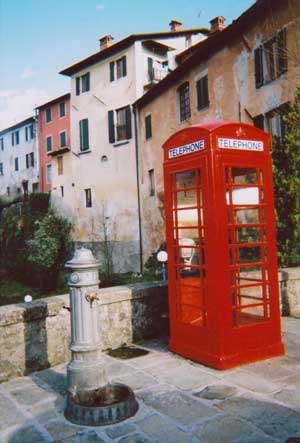Barga tourist information
Situated in the Garfagnana area of Tuscany, Barga is a good example of a typical Italian borgo. There’s not a great deal to do, so the town is best enjoyed as a short day trip or perhaps a long-term home for expats. Barga is connected to Italy’s rail network, though trains stop only at the valley bottom, from which there’s a stiff and unexciting climb to the old town on its hill. The bus from Lucca drops passengers instead at Barga’s western entrance, Porta Mancianella, where there’s also a car park (you should leave your car here if you are driving).
You see several encouraging signposts here and a town map, but a walk into the borgo still brings a surprise. The place has a closed-in, almost secretive, atmosphere. There are narrow lanes and flights of steps. A “piazza” is no more than a space where two vehicles can pass each other. The information office in Piazza Garibaldi is therefore easy to miss, and was itself – when we visited – rather closed-in and secretive, having almost no information in any language but Italian and not much of that either – this despite the fact that Barga is sometimes claimed to be ‘half-British’.
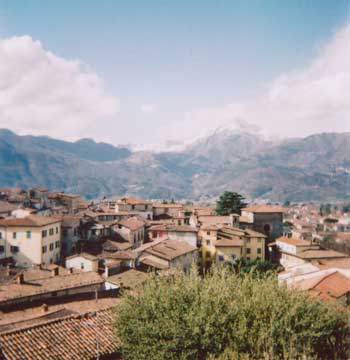
Barga’s shadowy passages are good to explore, although not for supplying a table for drinking coffee in the sun. One naturally looks also for height, and a view, and Barga does have that. A broad flight of stone steps leads finally up to a broad terrace in front of the Duomo. Here at last is air and light. The tiled roofs of the town are all below. Beyond them and across the valley rise the Apuan mountains and in particular the high domed summit – white for several months a year – of Monte Pania della Croce. Next to it you might see a bright spot just below the skyline, signifying a great natural arch, ten miles away. This is also visible from the car park but you need clear conditions and preferably afternoon sunshine. The view in the other direction, east, is partly blocked by the church but comprises a variegated landscape of fields, trees and farmhouses, sloping indefinitely upwards after an initial dip. If you notice a small knot of buildings, looking very old, eight or nine hundred feet (c.250m) above Barga on this side, it’s Sommocolonia – “high settlement”: The Garfagnana has many such high settlements, drawing the eye but frustratingly distant.
This cathedral is technically Romanesque but was humbled by an earthquake in the 1920s: the stones of the tower, a mixture of shades and degrees of weathering, have quite clearly been reassembled. The best of this, the main church of Barga, are the early and lovely detailing of the white facade and, in its rather bare interior, an equally beautiful marble pulpit. The view is also good from a little garden below the church to its right and from a pleasantly restored stretch of the town walls below its other side. Continuing in the same direction and downwards, the sombre ins and outs of passages, steps and walls become a reminder that Tuscan towns were not all frescoes and flamboyance. Here too is evidence of Barga’s medieval water supply, brought from outside the walls in an aqueduct and delivered to a basin just inside.
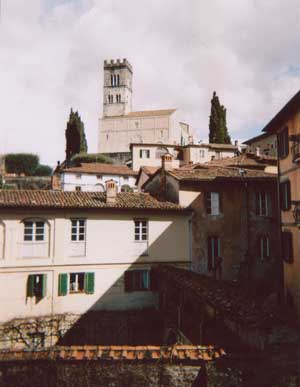
Most shops and businesses are below the old town and can be reached by crossing a stone bridge once followed by the main road, which now goes round a bend instead. There are just a handful of places to eat or drink in the borgo itself, including La Gelateria, not far in from the main gate, where you can find good ice creams or a pot of tea. This brings us to the British links, which are real if unobtrusive. Many Garfagnese have gone to the United Kingdom during the last century, some setting up successful restaurant or ice cream businesses in cities such as Glasgow. Some of these families have been very successful, producing (for example) the Garfagnana’s best footballer and more recently a well-known British actress. In turn, the substantial “British” element in the Garfagnana includes Italians who have returned or bought second homes here, as well as individuals or families with some Italian ancestry. A glance at noticeboards advertising local events reveals a few English names. By subtle enquiry (the way things are done in Italy) we also learned that you can buy Barga’s English-language magazine The Grapevine at a slightly curious bookshop close to the Porta Mancianella.
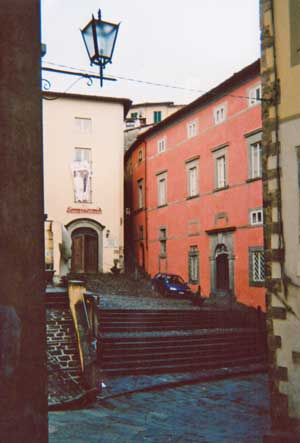
And just outside the walls, next to some old houses in Via Marconi, stands one of those traditional red telephone boxes much loved in the United Kingdom, this one presented to the city of Barga by Mauro Cecchetti of Edinburgh. The Garfagnana’s Scottish connection is apparently celebrated at an annual festa, featuring fish and chips.
Barga travel information
Barga makes a good day trip from Lucca, and is connected to the larger town by bus and rail services. If you are driving a hire-car, you could combine a visit to Barga with a tour of the Garfagnana area and the Apuan Alps.
> More about the Garfagnana
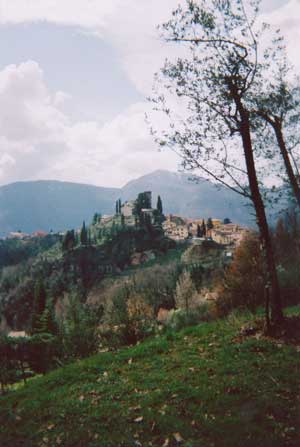
Barga accommodation
There are a few places to stay in Barga itself, and holidaymakers with cars can choose from a number of interesting and more rural options in the surrounding area, including farm-stay agriturismi. One of the best places to stay, and in walking distance of the sights, is the boutique hotel Villa Moorings, an elegant villa in its own grounds with a swimming pool. Casa Cordati is a small guesthouse in the historic centre offering value-for-money rooms, and another popular option is the “luxury bed and breakfast” with just three rooms Art Boutique Hotel Acchiappasogni, also in the historic centre.
> Find and book hotels in and around Barga
